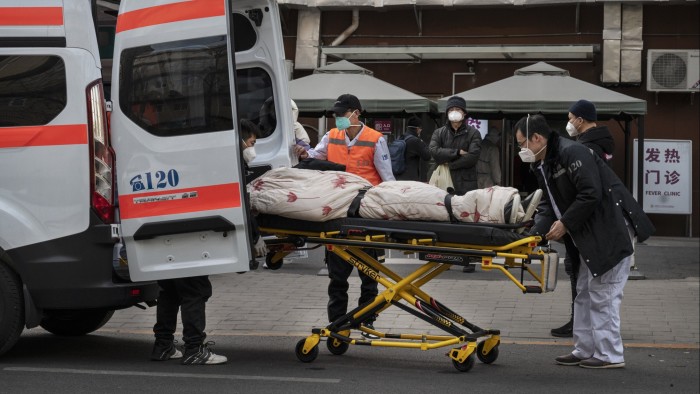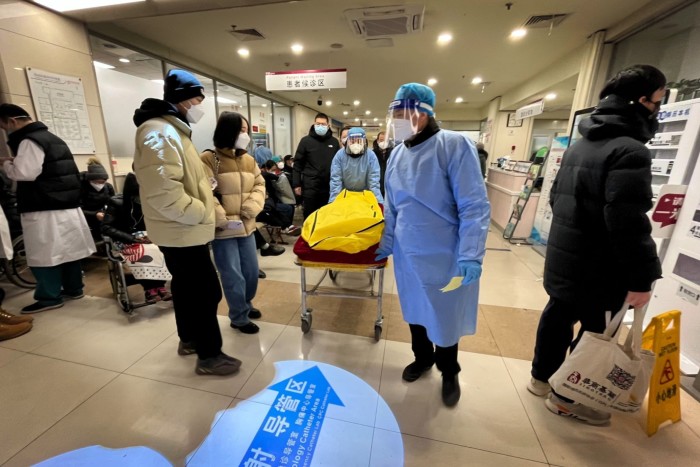‘We have no beds, we have no oxygen’: Covid overwhelms Beijing’s hospitals

Roula Khalaf, Editor of the FT, selects her favourite stories in this weekly newsletter.
Hospitals in Beijing are being overwhelmed by sick elderly Covid-19 patients just weeks after China abandoned its tough coronavirus containment measures with little preparation for the exit wave now ripping through the country.
Emergency rooms have run out of portable beds for patients, the infirm are waiting hours for ambulances and many doctors are too sick with Covid to work. Some facilities are so overloaded they are running out of oxygen hookups for those with respiratory problems.
“We have no beds, we have no oxygen and we have a room full of sick people waiting,” said a healthcare worker in Beijing Chaoyang Hospital’s emergency room, which has already filled up extra beds that it placed in a hallway and waiting room.
Beijing’s healthcare system was long thought to be among the best prepared in the country to deal with a surge of Covid infections. But the central government’s decision this month to abruptly abandon its draconian zero-Covid policy, which had held off the disease for nearly three years through mass testing and quarantines, has sparked one of the country’s biggest coronavirus outbreaks.
The influx has created a bottleneck in the capital’s emergency rooms in particular, according to conversations with a dozen medical professionals at five central Beijing ERs, who either declined to give their names or asked not to be named.
“All the doctors are laid up, we don’t have anywhere to send patients because other departments don’t have enough doctors,” said a neurologist on duty at the Beijing Friendship Hospital.
“The ER is clogged with patients — it’s taking us much longer than usual to move them onwards,” she said, coughing through her face mask. She and other doctors recovering from Covid were being sent first to support the emergency room, she said.

Overcrowded emergency rooms are leaving ambulance crews with nowhere to put the many bedridden patients they bring in, delaying rescue vehicles at hospitals and leaving families needing help at home waiting for hours.
“The problem is we can’t leave, we have a big backlog of people waiting on us but we are forced to wait here because there are no beds, the elderly can’t get off our stretcher, we can’t just throw them on the ground,” said one medic outside Chaoyang Hospital’s ER.
Inside the ER, a 90-year-old woman with Covid who the ambulance team had brought in was lying on the van’s stretcher, an intravenous drip into her arm. “We waited three hours for an ambulance, other hospitals wouldn’t take us at all,” her son said, declining to give his name. “We will take her home once we get medicine,” he said.
But six hours later the ambulance stretcher had been squeezed between portable beds and the woman hooked up to oxygen. A doctor in the hospital’s intensive care unit said it was also full.
Doctors at Chaoyang Hospital and Beijing Friendship Hospital said they were transferring patients to overflow wards at Beijing Chaoyang Integrative Medicine, a specially built emergency facility. By Tuesday, it was also nearing capacity.
“We have doctors but we have no beds,” said a nurse in one ward at the hospital. A doctor in another ward full of elderly Covid patients said he expected to fill the last available bed soon. An adjacent “emergency observation room” had been turned into a makeshift morgue. FT reporters saw six bodies inside on Tuesday.
China has officially reported an increase in Covid deaths of only six since December 3. Most analysts believe the real number is probably significantly higher as coronavirus infects tens of millions of people for the first time. China’s top health officials on Tuesday said they had changed how they count Covid deaths, excluding large numbers of coronavirus-related mortalities.
Ben Cowling, a professor of epidemiology at the University of Hong Kong, estimated that it had taken the Chinese capital, with a population of 22mn, about two weeks from loosening Covid controls to reach its infection peak.
“The latest omicron variants are so transmissible and because of the lack of mitigation measures as well, it’s really spread faster than anything that we’ve ever seen before,” he said, noting little appeared to have been done to slow the spread and flatten the curve.
“Even spreading cases out over a week or two could make a difference, because you just have more time to deal with things and when all the severe cases arrive at the same time, that’s the worst possible scenario,” he said.
That is the situation unfolding in Beijing. The city’s hospitals are strained even as residents who have recovered from Covid slowly begin returning to offices and restaurants.
“We couldn’t find a hospital bed. The wards were completely overwhelmed and short-staffed,” said the relative of a man in his 80s who died at home in Beijing over the weekend. He said doctors had advised the grandfather against vaccination because of his underlying health conditions.
The city has done a better job of keeping coronavirus out of its nursing homes, which from mid-September were ordered to close off from the outside world. Five Beijing nursing homes visited by the FT remained under strict lockdown. Employees, who were not allowed to leave, were using disinfectant to spray down any supplies that came in.
“We haven’t had any cases because we basically have no contact with the outside world,” shouted the manager of Zhaohe Elderly Care in south-east Beijing from behind a gate. He said 37 elderly Beijingers remained safe inside.
Chaoyang Hospital and Beijing Friendship Hospital referred questions to the Beijing Health Commission, which did not respond to a request for comment.
Comments